Healthcare IoT Mobile Application Project Design & Implementation
VerifiedAdded on 2023/04/20
|32
|6997
|117
Project
AI Summary
This document presents a project design for an IoT-based mobile healthcare application developed for a medium-scale healthcare firm facing data management challenges. The project aims to address issues related to increasing patient data volume, data security, and privacy risks using IoT technology. The research process involves a mix of qualitative and quantitative methods, including interviews, observations, surveys, and statistical analysis, to identify and assess the impact of the issues. Feasibility analysis covers project costs, hardware and software components, and expected profits. The project plan outlines different methodologies such as Agile and Waterfall, with Agile being the most suitable. The document details system analysis strategies, requirement elicitation steps, and database requirements. The goal is to develop a healthcare application that enhances data management, improves patient engagement, and ensures data security and privacy. Desklib provides students with access to this and many other solved assignments.
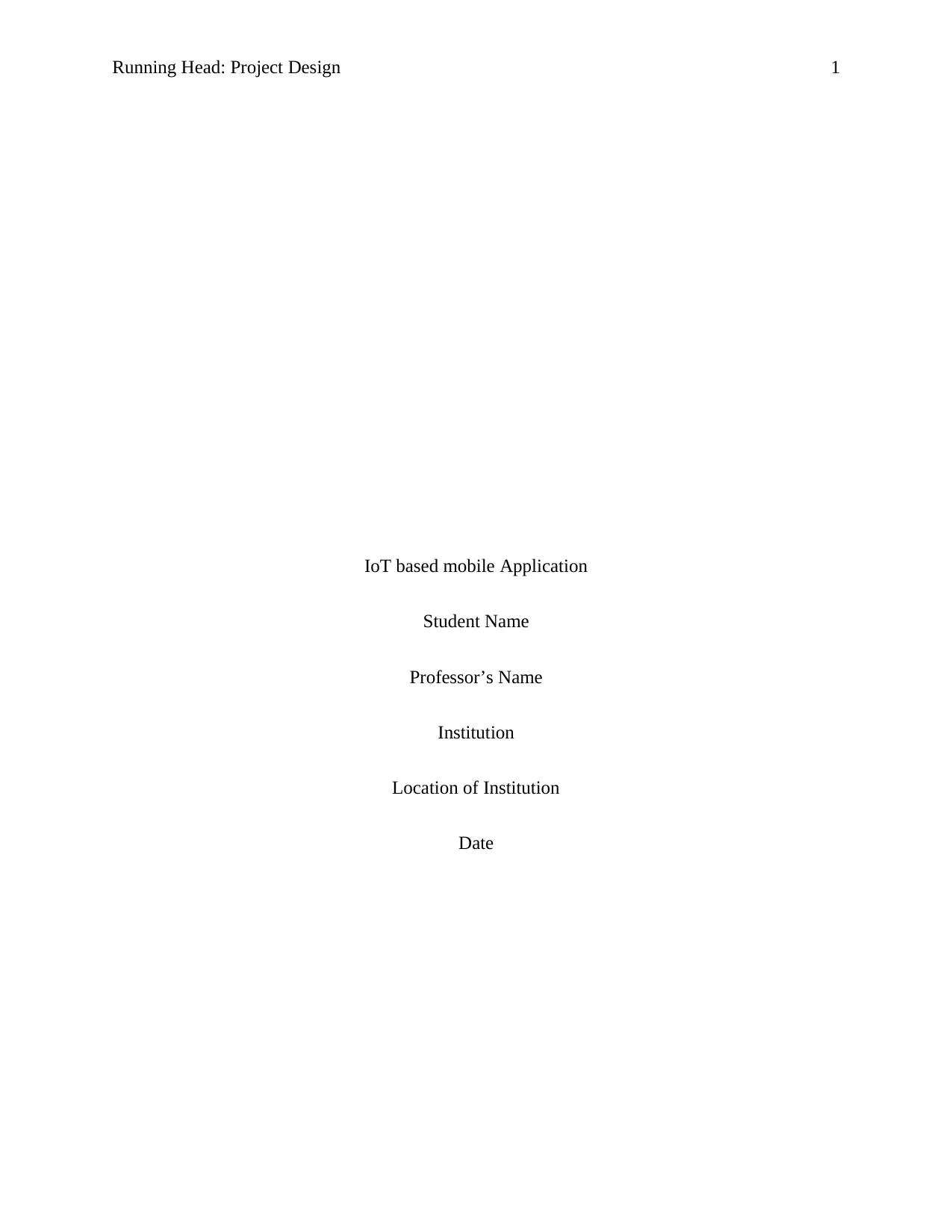
Running Head: Project Design 1
IoT based mobile Application
Student Name
Professor’s Name
Institution
Location of Institution
Date
IoT based mobile Application
Student Name
Professor’s Name
Institution
Location of Institution
Date
Paraphrase This Document
Need a fresh take? Get an instant paraphrase of this document with our AI Paraphraser
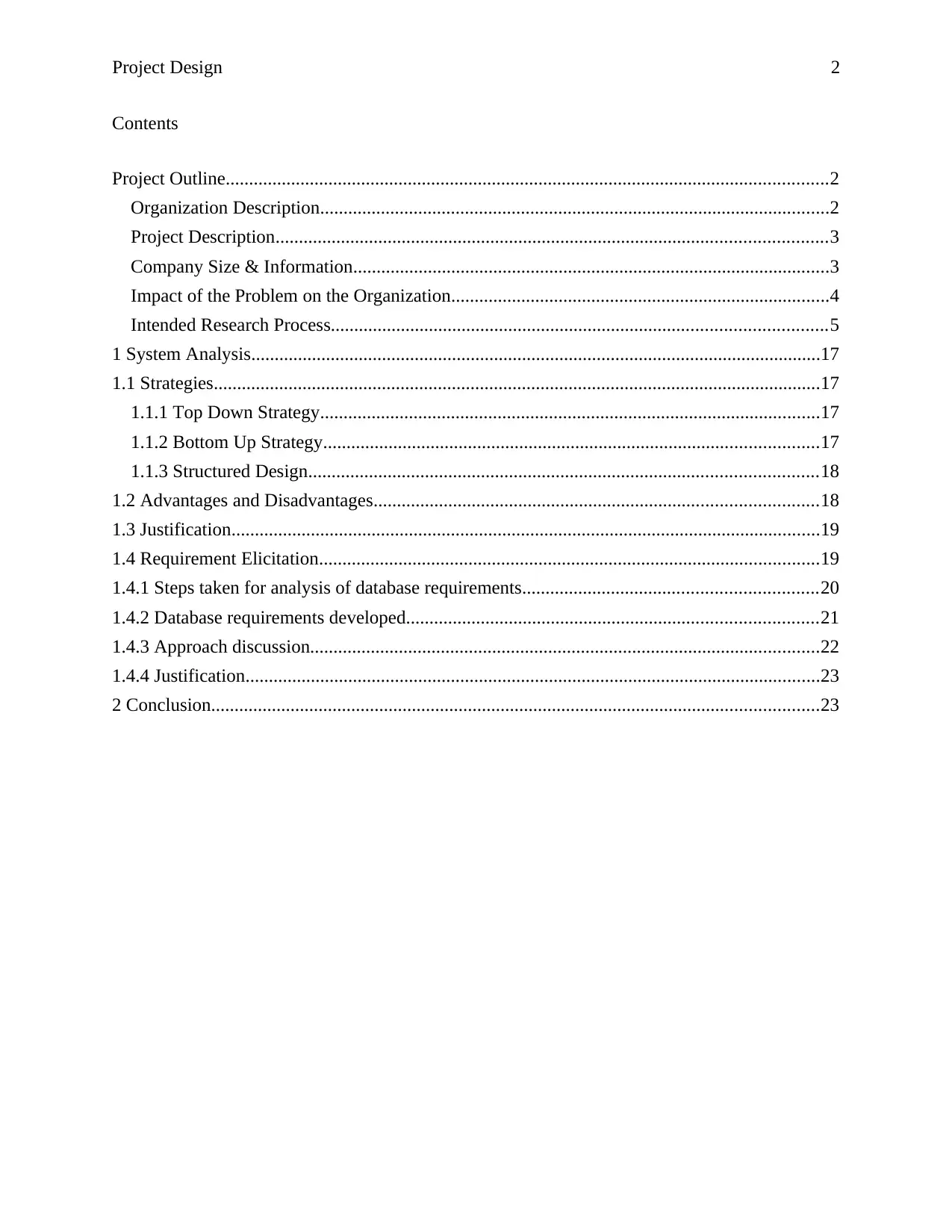
Project Design 2
Contents
Project Outline.................................................................................................................................2
Organization Description.............................................................................................................2
Project Description......................................................................................................................3
Company Size & Information......................................................................................................3
Impact of the Problem on the Organization.................................................................................4
Intended Research Process..........................................................................................................5
1 System Analysis..........................................................................................................................17
1.1 Strategies..................................................................................................................................17
1.1.1 Top Down Strategy...........................................................................................................17
1.1.2 Bottom Up Strategy..........................................................................................................17
1.1.3 Structured Design.............................................................................................................18
1.2 Advantages and Disadvantages...............................................................................................18
1.3 Justification..............................................................................................................................19
1.4 Requirement Elicitation...........................................................................................................19
1.4.1 Steps taken for analysis of database requirements...............................................................20
1.4.2 Database requirements developed........................................................................................21
1.4.3 Approach discussion.............................................................................................................22
1.4.4 Justification...........................................................................................................................23
2 Conclusion..................................................................................................................................23
Contents
Project Outline.................................................................................................................................2
Organization Description.............................................................................................................2
Project Description......................................................................................................................3
Company Size & Information......................................................................................................3
Impact of the Problem on the Organization.................................................................................4
Intended Research Process..........................................................................................................5
1 System Analysis..........................................................................................................................17
1.1 Strategies..................................................................................................................................17
1.1.1 Top Down Strategy...........................................................................................................17
1.1.2 Bottom Up Strategy..........................................................................................................17
1.1.3 Structured Design.............................................................................................................18
1.2 Advantages and Disadvantages...............................................................................................18
1.3 Justification..............................................................................................................................19
1.4 Requirement Elicitation...........................................................................................................19
1.4.1 Steps taken for analysis of database requirements...............................................................20
1.4.2 Database requirements developed........................................................................................21
1.4.3 Approach discussion.............................................................................................................22
1.4.4 Justification...........................................................................................................................23
2 Conclusion..................................................................................................................................23
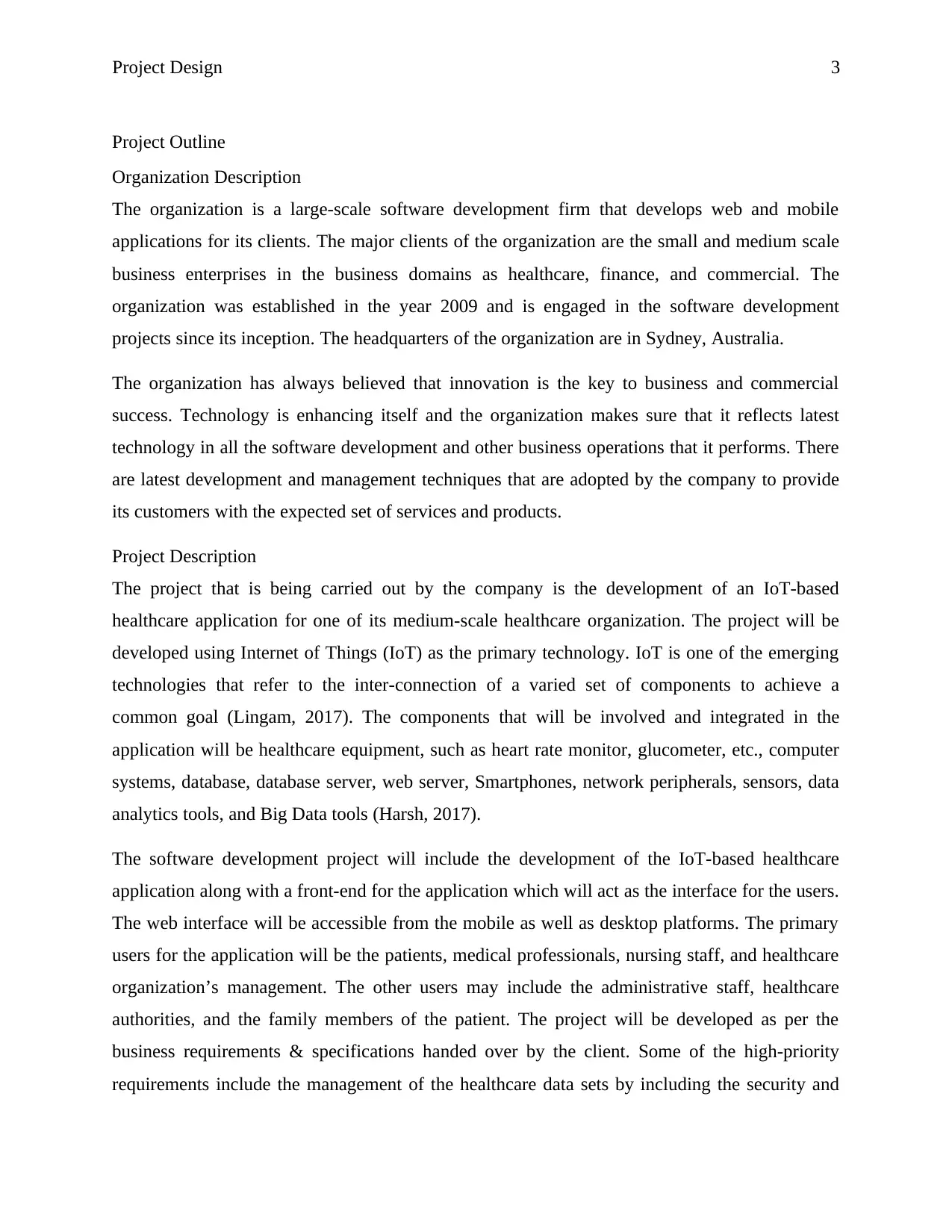
Project Design 3
Project Outline
Organization Description
The organization is a large-scale software development firm that develops web and mobile
applications for its clients. The major clients of the organization are the small and medium scale
business enterprises in the business domains as healthcare, finance, and commercial. The
organization was established in the year 2009 and is engaged in the software development
projects since its inception. The headquarters of the organization are in Sydney, Australia.
The organization has always believed that innovation is the key to business and commercial
success. Technology is enhancing itself and the organization makes sure that it reflects latest
technology in all the software development and other business operations that it performs. There
are latest development and management techniques that are adopted by the company to provide
its customers with the expected set of services and products.
Project Description
The project that is being carried out by the company is the development of an IoT-based
healthcare application for one of its medium-scale healthcare organization. The project will be
developed using Internet of Things (IoT) as the primary technology. IoT is one of the emerging
technologies that refer to the inter-connection of a varied set of components to achieve a
common goal (Lingam, 2017). The components that will be involved and integrated in the
application will be healthcare equipment, such as heart rate monitor, glucometer, etc., computer
systems, database, database server, web server, Smartphones, network peripherals, sensors, data
analytics tools, and Big Data tools (Harsh, 2017).
The software development project will include the development of the IoT-based healthcare
application along with a front-end for the application which will act as the interface for the users.
The web interface will be accessible from the mobile as well as desktop platforms. The primary
users for the application will be the patients, medical professionals, nursing staff, and healthcare
organization’s management. The other users may include the administrative staff, healthcare
authorities, and the family members of the patient. The project will be developed as per the
business requirements & specifications handed over by the client. Some of the high-priority
requirements include the management of the healthcare data sets by including the security and
Project Outline
Organization Description
The organization is a large-scale software development firm that develops web and mobile
applications for its clients. The major clients of the organization are the small and medium scale
business enterprises in the business domains as healthcare, finance, and commercial. The
organization was established in the year 2009 and is engaged in the software development
projects since its inception. The headquarters of the organization are in Sydney, Australia.
The organization has always believed that innovation is the key to business and commercial
success. Technology is enhancing itself and the organization makes sure that it reflects latest
technology in all the software development and other business operations that it performs. There
are latest development and management techniques that are adopted by the company to provide
its customers with the expected set of services and products.
Project Description
The project that is being carried out by the company is the development of an IoT-based
healthcare application for one of its medium-scale healthcare organization. The project will be
developed using Internet of Things (IoT) as the primary technology. IoT is one of the emerging
technologies that refer to the inter-connection of a varied set of components to achieve a
common goal (Lingam, 2017). The components that will be involved and integrated in the
application will be healthcare equipment, such as heart rate monitor, glucometer, etc., computer
systems, database, database server, web server, Smartphones, network peripherals, sensors, data
analytics tools, and Big Data tools (Harsh, 2017).
The software development project will include the development of the IoT-based healthcare
application along with a front-end for the application which will act as the interface for the users.
The web interface will be accessible from the mobile as well as desktop platforms. The primary
users for the application will be the patients, medical professionals, nursing staff, and healthcare
organization’s management. The other users may include the administrative staff, healthcare
authorities, and the family members of the patient. The project will be developed as per the
business requirements & specifications handed over by the client. Some of the high-priority
requirements include the management of the healthcare data sets by including the security and
⊘ This is a preview!⊘
Do you want full access?
Subscribe today to unlock all pages.

Trusted by 1+ million students worldwide
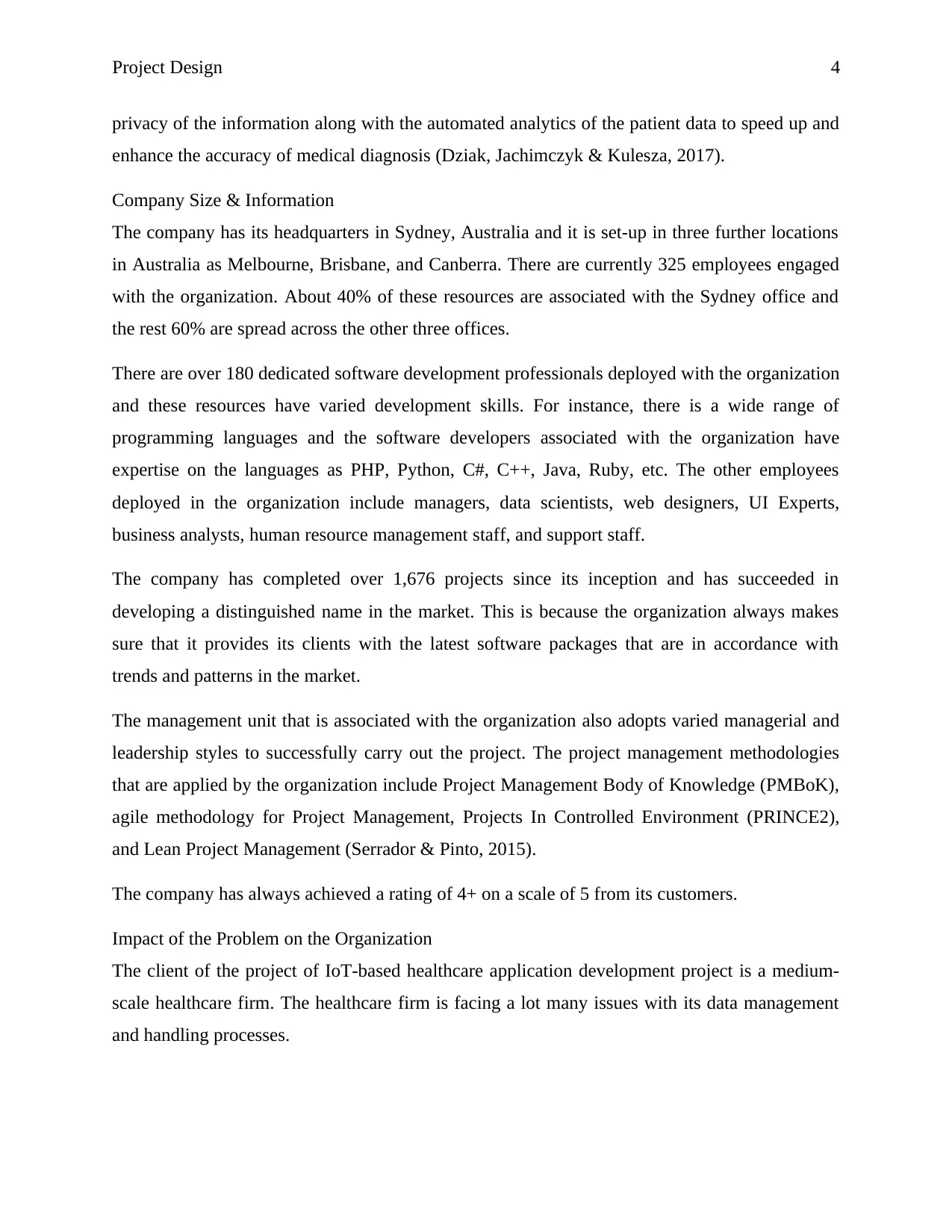
Project Design 4
privacy of the information along with the automated analytics of the patient data to speed up and
enhance the accuracy of medical diagnosis (Dziak, Jachimczyk & Kulesza, 2017).
Company Size & Information
The company has its headquarters in Sydney, Australia and it is set-up in three further locations
in Australia as Melbourne, Brisbane, and Canberra. There are currently 325 employees engaged
with the organization. About 40% of these resources are associated with the Sydney office and
the rest 60% are spread across the other three offices.
There are over 180 dedicated software development professionals deployed with the organization
and these resources have varied development skills. For instance, there is a wide range of
programming languages and the software developers associated with the organization have
expertise on the languages as PHP, Python, C#, C++, Java, Ruby, etc. The other employees
deployed in the organization include managers, data scientists, web designers, UI Experts,
business analysts, human resource management staff, and support staff.
The company has completed over 1,676 projects since its inception and has succeeded in
developing a distinguished name in the market. This is because the organization always makes
sure that it provides its clients with the latest software packages that are in accordance with
trends and patterns in the market.
The management unit that is associated with the organization also adopts varied managerial and
leadership styles to successfully carry out the project. The project management methodologies
that are applied by the organization include Project Management Body of Knowledge (PMBoK),
agile methodology for Project Management, Projects In Controlled Environment (PRINCE2),
and Lean Project Management (Serrador & Pinto, 2015).
The company has always achieved a rating of 4+ on a scale of 5 from its customers.
Impact of the Problem on the Organization
The client of the project of IoT-based healthcare application development project is a medium-
scale healthcare firm. The healthcare firm is facing a lot many issues with its data management
and handling processes.
privacy of the information along with the automated analytics of the patient data to speed up and
enhance the accuracy of medical diagnosis (Dziak, Jachimczyk & Kulesza, 2017).
Company Size & Information
The company has its headquarters in Sydney, Australia and it is set-up in three further locations
in Australia as Melbourne, Brisbane, and Canberra. There are currently 325 employees engaged
with the organization. About 40% of these resources are associated with the Sydney office and
the rest 60% are spread across the other three offices.
There are over 180 dedicated software development professionals deployed with the organization
and these resources have varied development skills. For instance, there is a wide range of
programming languages and the software developers associated with the organization have
expertise on the languages as PHP, Python, C#, C++, Java, Ruby, etc. The other employees
deployed in the organization include managers, data scientists, web designers, UI Experts,
business analysts, human resource management staff, and support staff.
The company has completed over 1,676 projects since its inception and has succeeded in
developing a distinguished name in the market. This is because the organization always makes
sure that it provides its clients with the latest software packages that are in accordance with
trends and patterns in the market.
The management unit that is associated with the organization also adopts varied managerial and
leadership styles to successfully carry out the project. The project management methodologies
that are applied by the organization include Project Management Body of Knowledge (PMBoK),
agile methodology for Project Management, Projects In Controlled Environment (PRINCE2),
and Lean Project Management (Serrador & Pinto, 2015).
The company has always achieved a rating of 4+ on a scale of 5 from its customers.
Impact of the Problem on the Organization
The client of the project of IoT-based healthcare application development project is a medium-
scale healthcare firm. The healthcare firm is facing a lot many issues with its data management
and handling processes.
Paraphrase This Document
Need a fresh take? Get an instant paraphrase of this document with our AI Paraphraser
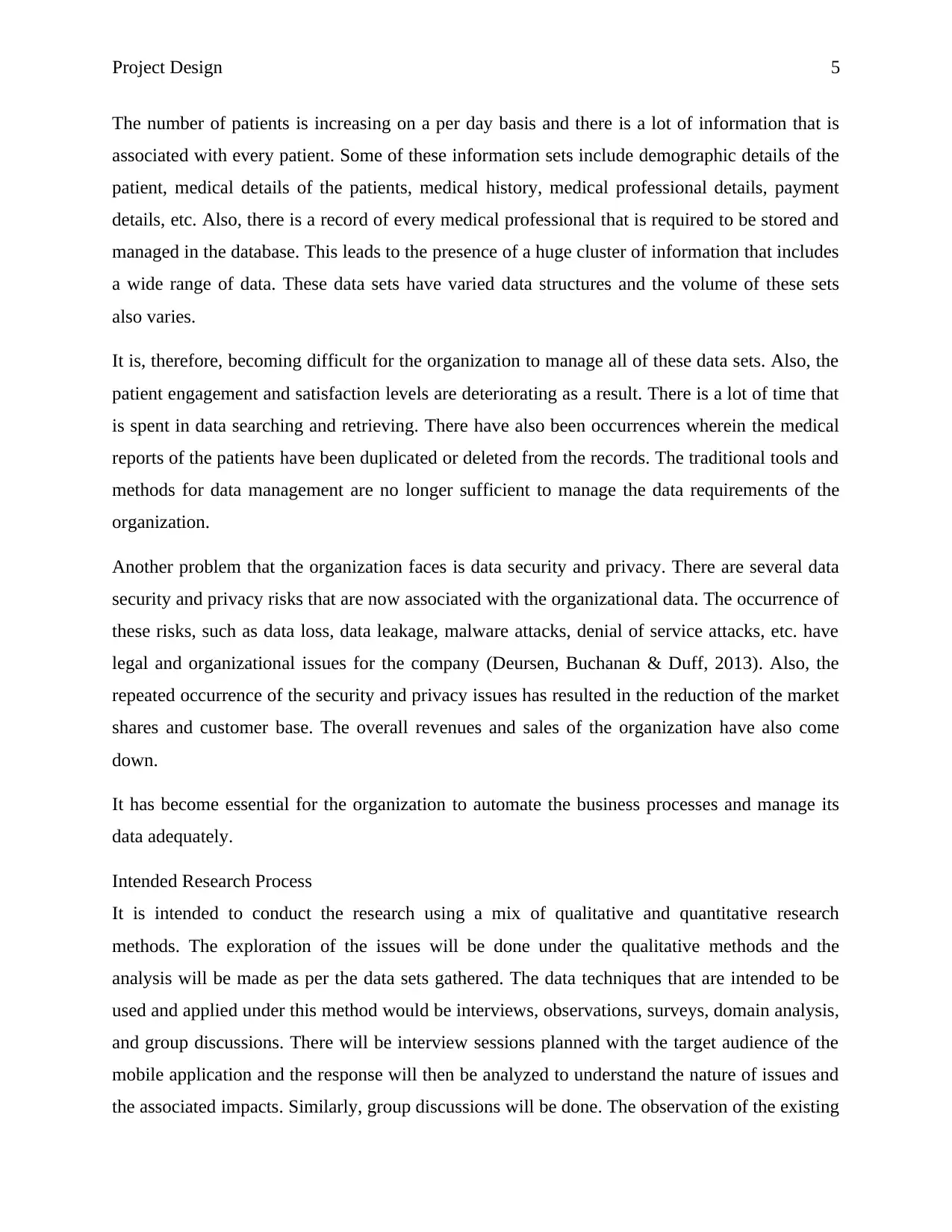
Project Design 5
The number of patients is increasing on a per day basis and there is a lot of information that is
associated with every patient. Some of these information sets include demographic details of the
patient, medical details of the patients, medical history, medical professional details, payment
details, etc. Also, there is a record of every medical professional that is required to be stored and
managed in the database. This leads to the presence of a huge cluster of information that includes
a wide range of data. These data sets have varied data structures and the volume of these sets
also varies.
It is, therefore, becoming difficult for the organization to manage all of these data sets. Also, the
patient engagement and satisfaction levels are deteriorating as a result. There is a lot of time that
is spent in data searching and retrieving. There have also been occurrences wherein the medical
reports of the patients have been duplicated or deleted from the records. The traditional tools and
methods for data management are no longer sufficient to manage the data requirements of the
organization.
Another problem that the organization faces is data security and privacy. There are several data
security and privacy risks that are now associated with the organizational data. The occurrence of
these risks, such as data loss, data leakage, malware attacks, denial of service attacks, etc. have
legal and organizational issues for the company (Deursen, Buchanan & Duff, 2013). Also, the
repeated occurrence of the security and privacy issues has resulted in the reduction of the market
shares and customer base. The overall revenues and sales of the organization have also come
down.
It has become essential for the organization to automate the business processes and manage its
data adequately.
Intended Research Process
It is intended to conduct the research using a mix of qualitative and quantitative research
methods. The exploration of the issues will be done under the qualitative methods and the
analysis will be made as per the data sets gathered. The data techniques that are intended to be
used and applied under this method would be interviews, observations, surveys, domain analysis,
and group discussions. There will be interview sessions planned with the target audience of the
mobile application and the response will then be analyzed to understand the nature of issues and
the associated impacts. Similarly, group discussions will be done. The observation of the existing
The number of patients is increasing on a per day basis and there is a lot of information that is
associated with every patient. Some of these information sets include demographic details of the
patient, medical details of the patients, medical history, medical professional details, payment
details, etc. Also, there is a record of every medical professional that is required to be stored and
managed in the database. This leads to the presence of a huge cluster of information that includes
a wide range of data. These data sets have varied data structures and the volume of these sets
also varies.
It is, therefore, becoming difficult for the organization to manage all of these data sets. Also, the
patient engagement and satisfaction levels are deteriorating as a result. There is a lot of time that
is spent in data searching and retrieving. There have also been occurrences wherein the medical
reports of the patients have been duplicated or deleted from the records. The traditional tools and
methods for data management are no longer sufficient to manage the data requirements of the
organization.
Another problem that the organization faces is data security and privacy. There are several data
security and privacy risks that are now associated with the organizational data. The occurrence of
these risks, such as data loss, data leakage, malware attacks, denial of service attacks, etc. have
legal and organizational issues for the company (Deursen, Buchanan & Duff, 2013). Also, the
repeated occurrence of the security and privacy issues has resulted in the reduction of the market
shares and customer base. The overall revenues and sales of the organization have also come
down.
It has become essential for the organization to automate the business processes and manage its
data adequately.
Intended Research Process
It is intended to conduct the research using a mix of qualitative and quantitative research
methods. The exploration of the issues will be done under the qualitative methods and the
analysis will be made as per the data sets gathered. The data techniques that are intended to be
used and applied under this method would be interviews, observations, surveys, domain analysis,
and group discussions. There will be interview sessions planned with the target audience of the
mobile application and the response will then be analyzed to understand the nature of issues and
the associated impacts. Similarly, group discussions will be done. The observation of the existing
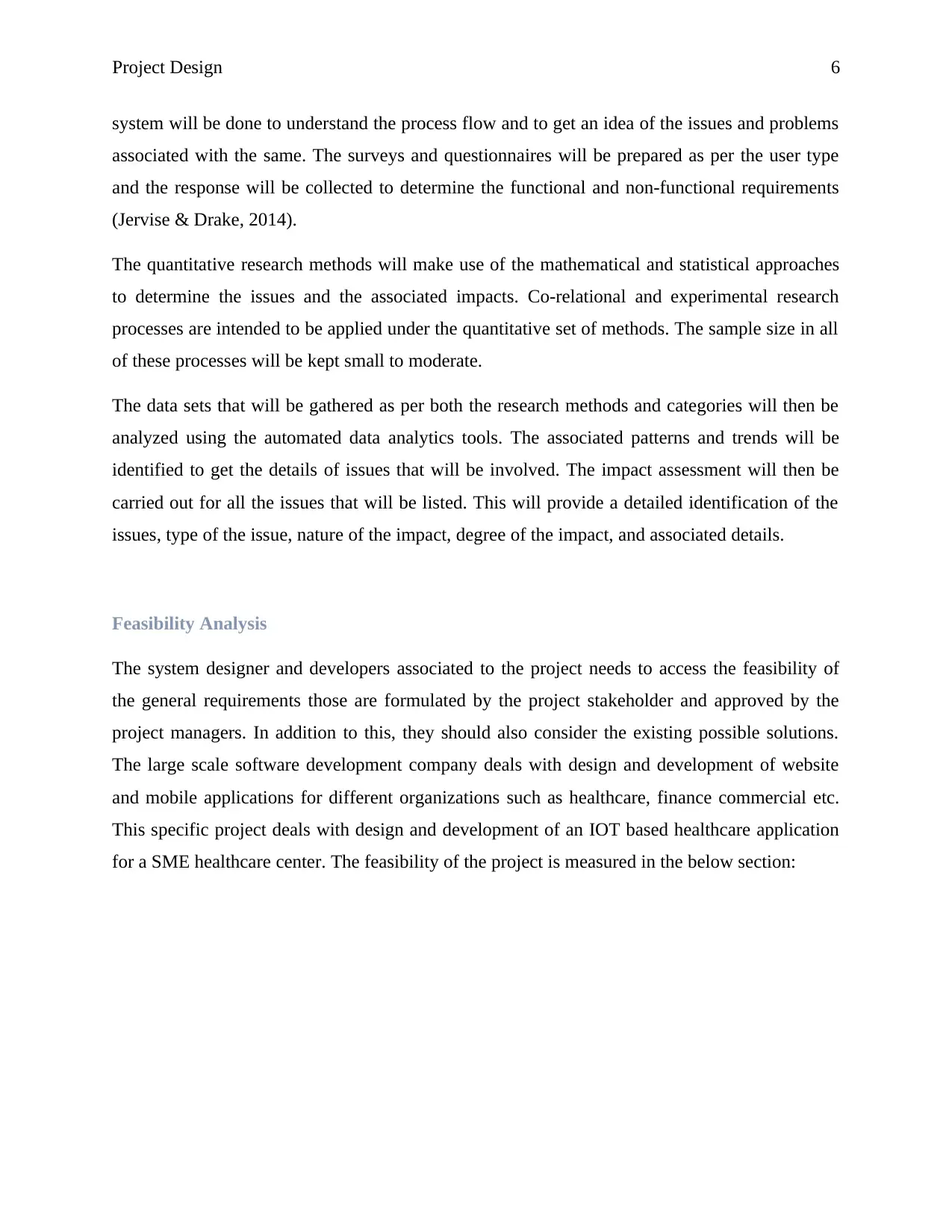
Project Design 6
system will be done to understand the process flow and to get an idea of the issues and problems
associated with the same. The surveys and questionnaires will be prepared as per the user type
and the response will be collected to determine the functional and non-functional requirements
(Jervise & Drake, 2014).
The quantitative research methods will make use of the mathematical and statistical approaches
to determine the issues and the associated impacts. Co-relational and experimental research
processes are intended to be applied under the quantitative set of methods. The sample size in all
of these processes will be kept small to moderate.
The data sets that will be gathered as per both the research methods and categories will then be
analyzed using the automated data analytics tools. The associated patterns and trends will be
identified to get the details of issues that will be involved. The impact assessment will then be
carried out for all the issues that will be listed. This will provide a detailed identification of the
issues, type of the issue, nature of the impact, degree of the impact, and associated details.
Feasibility Analysis
The system designer and developers associated to the project needs to access the feasibility of
the general requirements those are formulated by the project stakeholder and approved by the
project managers. In addition to this, they should also consider the existing possible solutions.
The large scale software development company deals with design and development of website
and mobile applications for different organizations such as healthcare, finance commercial etc.
This specific project deals with design and development of an IOT based healthcare application
for a SME healthcare center. The feasibility of the project is measured in the below section:
system will be done to understand the process flow and to get an idea of the issues and problems
associated with the same. The surveys and questionnaires will be prepared as per the user type
and the response will be collected to determine the functional and non-functional requirements
(Jervise & Drake, 2014).
The quantitative research methods will make use of the mathematical and statistical approaches
to determine the issues and the associated impacts. Co-relational and experimental research
processes are intended to be applied under the quantitative set of methods. The sample size in all
of these processes will be kept small to moderate.
The data sets that will be gathered as per both the research methods and categories will then be
analyzed using the automated data analytics tools. The associated patterns and trends will be
identified to get the details of issues that will be involved. The impact assessment will then be
carried out for all the issues that will be listed. This will provide a detailed identification of the
issues, type of the issue, nature of the impact, degree of the impact, and associated details.
Feasibility Analysis
The system designer and developers associated to the project needs to access the feasibility of
the general requirements those are formulated by the project stakeholder and approved by the
project managers. In addition to this, they should also consider the existing possible solutions.
The large scale software development company deals with design and development of website
and mobile applications for different organizations such as healthcare, finance commercial etc.
This specific project deals with design and development of an IOT based healthcare application
for a SME healthcare center. The feasibility of the project is measured in the below section:
⊘ This is a preview!⊘
Do you want full access?
Subscribe today to unlock all pages.

Trusted by 1+ million students worldwide
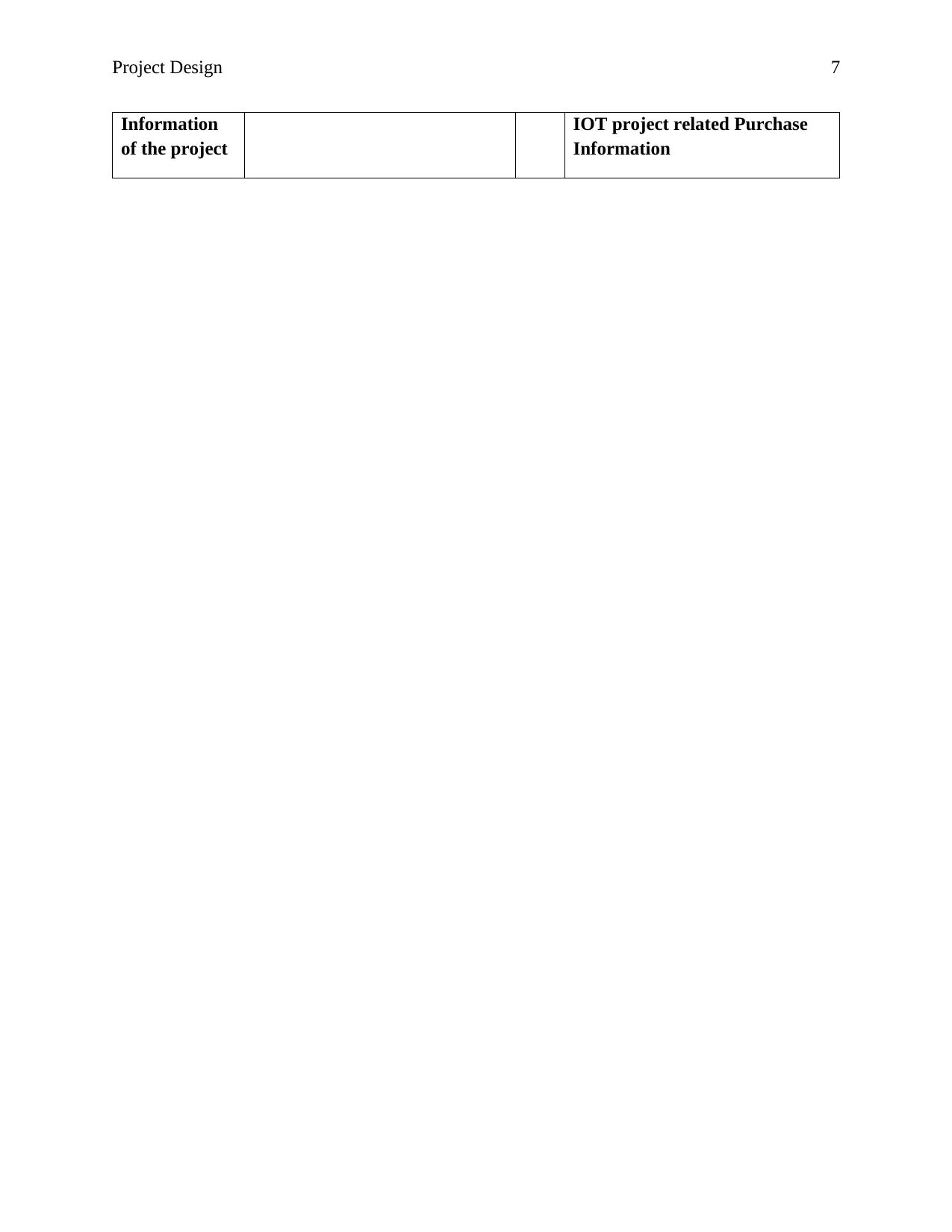
Project Design 7
Information
of the project
IOT project related Purchase
Information
Information
of the project
IOT project related Purchase
Information
Paraphrase This Document
Need a fresh take? Get an instant paraphrase of this document with our AI Paraphraser
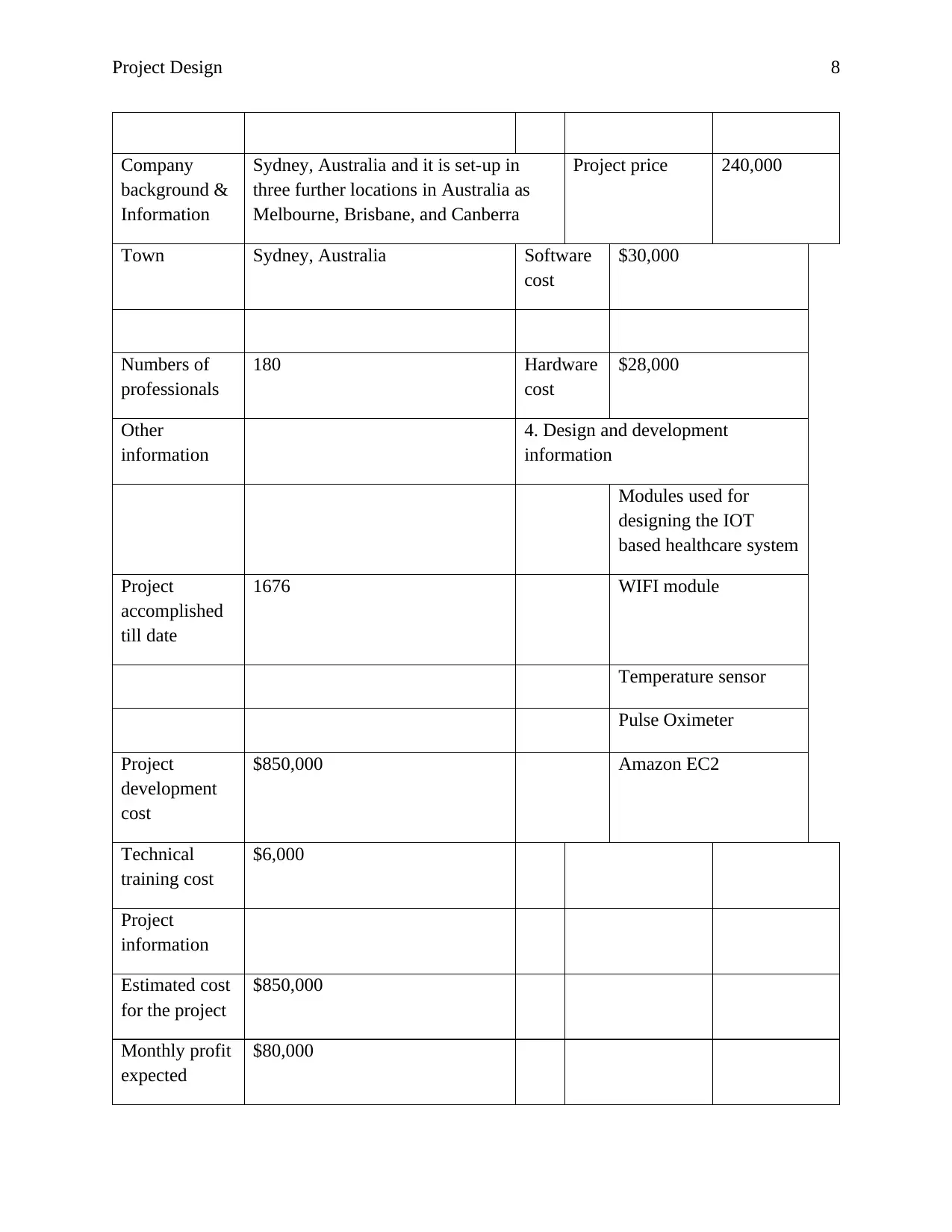
Project Design 8
Company
background &
Information
Sydney, Australia and it is set-up in
three further locations in Australia as
Melbourne, Brisbane, and Canberra
Project price 240,000
Town Sydney, Australia Software
cost
$30,000
Numbers of
professionals
180 Hardware
cost
$28,000
Other
information
4. Design and development
information
Modules used for
designing the IOT
based healthcare system
Project
accomplished
till date
1676 WIFI module
Temperature sensor
Pulse Oximeter
Project
development
cost
$850,000 Amazon EC2
Technical
training cost
$6,000
Project
information
Estimated cost
for the project
$850,000
Monthly profit
expected
$80,000
Company
background &
Information
Sydney, Australia and it is set-up in
three further locations in Australia as
Melbourne, Brisbane, and Canberra
Project price 240,000
Town Sydney, Australia Software
cost
$30,000
Numbers of
professionals
180 Hardware
cost
$28,000
Other
information
4. Design and development
information
Modules used for
designing the IOT
based healthcare system
Project
accomplished
till date
1676 WIFI module
Temperature sensor
Pulse Oximeter
Project
development
cost
$850,000 Amazon EC2
Technical
training cost
$6,000
Project
information
Estimated cost
for the project
$850,000
Monthly profit
expected
$80,000
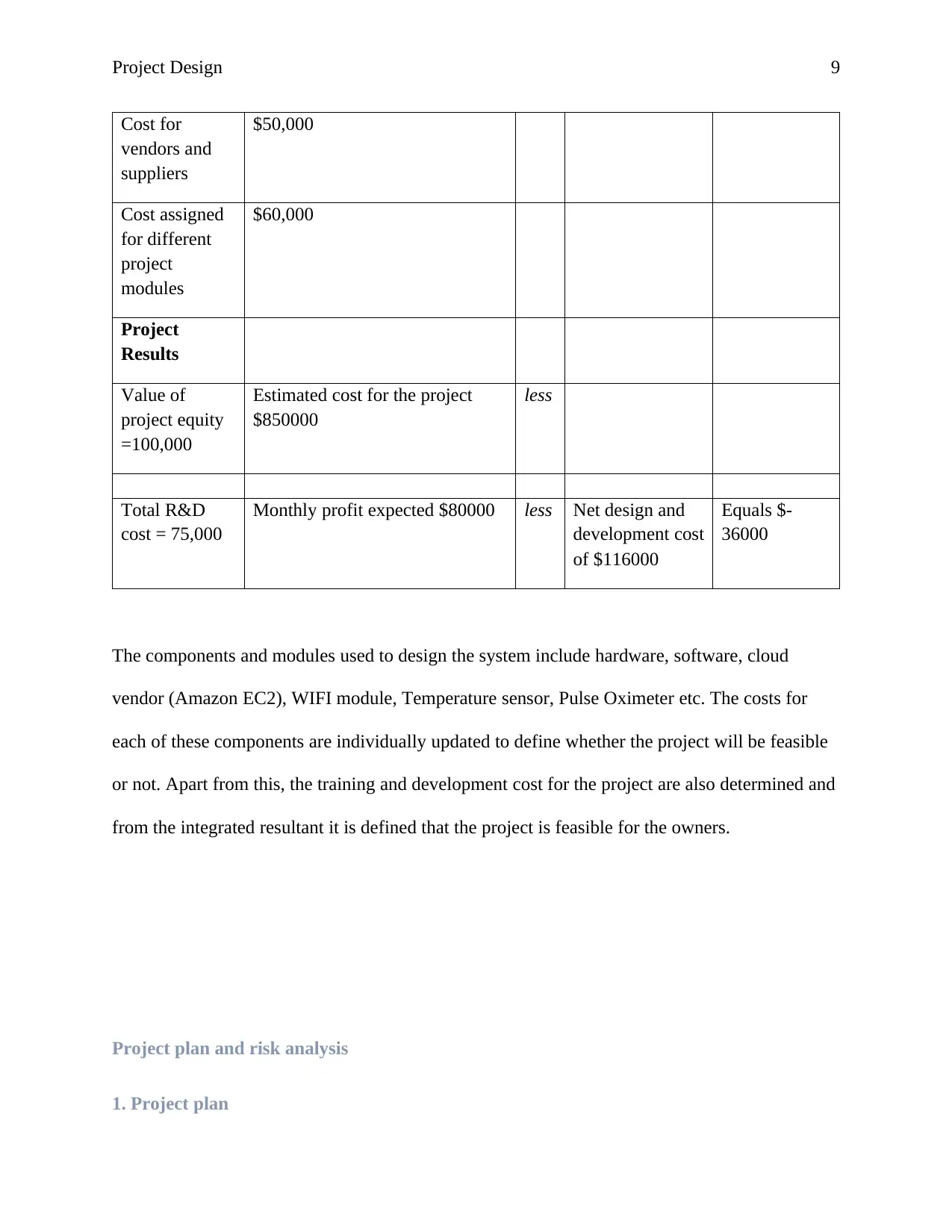
Project Design 9
Cost for
vendors and
suppliers
$50,000
Cost assigned
for different
project
modules
$60,000
Project
Results
Value of
project equity
=100,000
Estimated cost for the project
$850000
less
Total R&D
cost = 75,000
Monthly profit expected $80000 less Net design and
development cost
of $116000
Equals $-
36000
The components and modules used to design the system include hardware, software, cloud
vendor (Amazon EC2), WIFI module, Temperature sensor, Pulse Oximeter etc. The costs for
each of these components are individually updated to define whether the project will be feasible
or not. Apart from this, the training and development cost for the project are also determined and
from the integrated resultant it is defined that the project is feasible for the owners.
Project plan and risk analysis
1. Project plan
Cost for
vendors and
suppliers
$50,000
Cost assigned
for different
project
modules
$60,000
Project
Results
Value of
project equity
=100,000
Estimated cost for the project
$850000
less
Total R&D
cost = 75,000
Monthly profit expected $80000 less Net design and
development cost
of $116000
Equals $-
36000
The components and modules used to design the system include hardware, software, cloud
vendor (Amazon EC2), WIFI module, Temperature sensor, Pulse Oximeter etc. The costs for
each of these components are individually updated to define whether the project will be feasible
or not. Apart from this, the training and development cost for the project are also determined and
from the integrated resultant it is defined that the project is feasible for the owners.
Project plan and risk analysis
1. Project plan
⊘ This is a preview!⊘
Do you want full access?
Subscribe today to unlock all pages.

Trusted by 1+ million students worldwide
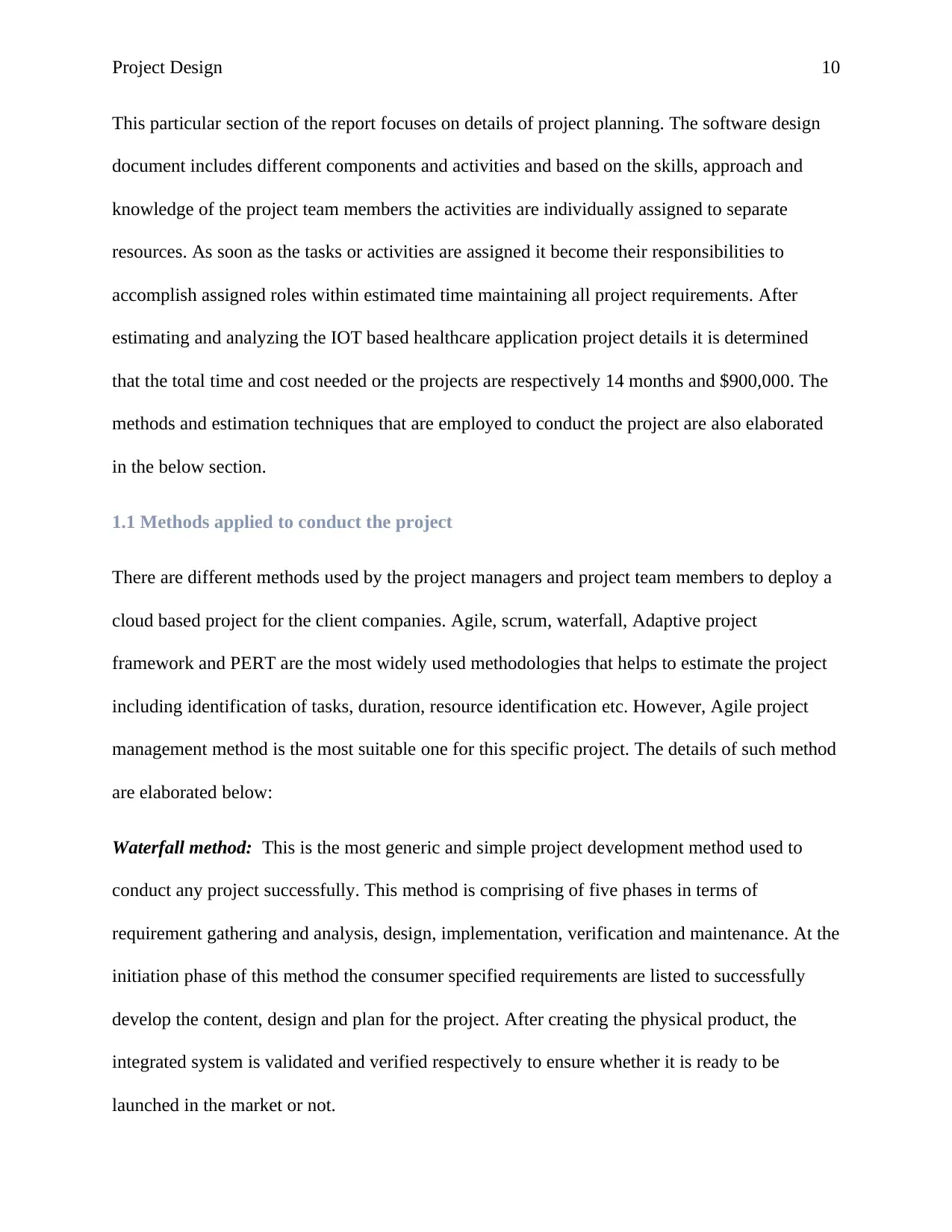
Project Design 10
This particular section of the report focuses on details of project planning. The software design
document includes different components and activities and based on the skills, approach and
knowledge of the project team members the activities are individually assigned to separate
resources. As soon as the tasks or activities are assigned it become their responsibilities to
accomplish assigned roles within estimated time maintaining all project requirements. After
estimating and analyzing the IOT based healthcare application project details it is determined
that the total time and cost needed or the projects are respectively 14 months and $900,000. The
methods and estimation techniques that are employed to conduct the project are also elaborated
in the below section.
1.1 Methods applied to conduct the project
There are different methods used by the project managers and project team members to deploy a
cloud based project for the client companies. Agile, scrum, waterfall, Adaptive project
framework and PERT are the most widely used methodologies that helps to estimate the project
including identification of tasks, duration, resource identification etc. However, Agile project
management method is the most suitable one for this specific project. The details of such method
are elaborated below:
Waterfall method: This is the most generic and simple project development method used to
conduct any project successfully. This method is comprising of five phases in terms of
requirement gathering and analysis, design, implementation, verification and maintenance. At the
initiation phase of this method the consumer specified requirements are listed to successfully
develop the content, design and plan for the project. After creating the physical product, the
integrated system is validated and verified respectively to ensure whether it is ready to be
launched in the market or not.
This particular section of the report focuses on details of project planning. The software design
document includes different components and activities and based on the skills, approach and
knowledge of the project team members the activities are individually assigned to separate
resources. As soon as the tasks or activities are assigned it become their responsibilities to
accomplish assigned roles within estimated time maintaining all project requirements. After
estimating and analyzing the IOT based healthcare application project details it is determined
that the total time and cost needed or the projects are respectively 14 months and $900,000. The
methods and estimation techniques that are employed to conduct the project are also elaborated
in the below section.
1.1 Methods applied to conduct the project
There are different methods used by the project managers and project team members to deploy a
cloud based project for the client companies. Agile, scrum, waterfall, Adaptive project
framework and PERT are the most widely used methodologies that helps to estimate the project
including identification of tasks, duration, resource identification etc. However, Agile project
management method is the most suitable one for this specific project. The details of such method
are elaborated below:
Waterfall method: This is the most generic and simple project development method used to
conduct any project successfully. This method is comprising of five phases in terms of
requirement gathering and analysis, design, implementation, verification and maintenance. At the
initiation phase of this method the consumer specified requirements are listed to successfully
develop the content, design and plan for the project. After creating the physical product, the
integrated system is validated and verified respectively to ensure whether it is ready to be
launched in the market or not.
Paraphrase This Document
Need a fresh take? Get an instant paraphrase of this document with our AI Paraphraser
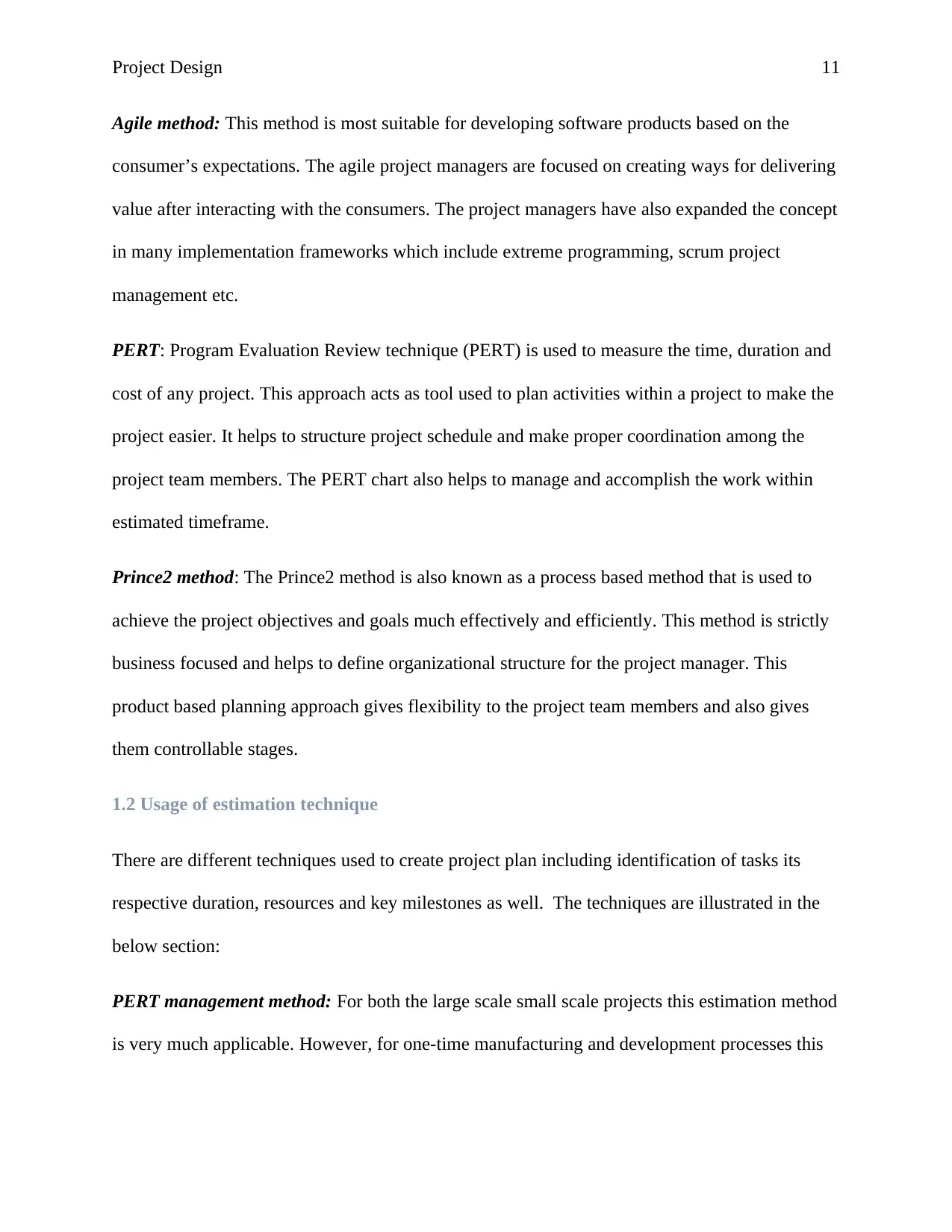
Project Design 11
Agile method: This method is most suitable for developing software products based on the
consumer’s expectations. The agile project managers are focused on creating ways for delivering
value after interacting with the consumers. The project managers have also expanded the concept
in many implementation frameworks which include extreme programming, scrum project
management etc.
PERT: Program Evaluation Review technique (PERT) is used to measure the time, duration and
cost of any project. This approach acts as tool used to plan activities within a project to make the
project easier. It helps to structure project schedule and make proper coordination among the
project team members. The PERT chart also helps to manage and accomplish the work within
estimated timeframe.
Prince2 method: The Prince2 method is also known as a process based method that is used to
achieve the project objectives and goals much effectively and efficiently. This method is strictly
business focused and helps to define organizational structure for the project manager. This
product based planning approach gives flexibility to the project team members and also gives
them controllable stages.
1.2 Usage of estimation technique
There are different techniques used to create project plan including identification of tasks its
respective duration, resources and key milestones as well. The techniques are illustrated in the
below section:
PERT management method: For both the large scale small scale projects this estimation method
is very much applicable. However, for one-time manufacturing and development processes this
Agile method: This method is most suitable for developing software products based on the
consumer’s expectations. The agile project managers are focused on creating ways for delivering
value after interacting with the consumers. The project managers have also expanded the concept
in many implementation frameworks which include extreme programming, scrum project
management etc.
PERT: Program Evaluation Review technique (PERT) is used to measure the time, duration and
cost of any project. This approach acts as tool used to plan activities within a project to make the
project easier. It helps to structure project schedule and make proper coordination among the
project team members. The PERT chart also helps to manage and accomplish the work within
estimated timeframe.
Prince2 method: The Prince2 method is also known as a process based method that is used to
achieve the project objectives and goals much effectively and efficiently. This method is strictly
business focused and helps to define organizational structure for the project manager. This
product based planning approach gives flexibility to the project team members and also gives
them controllable stages.
1.2 Usage of estimation technique
There are different techniques used to create project plan including identification of tasks its
respective duration, resources and key milestones as well. The techniques are illustrated in the
below section:
PERT management method: For both the large scale small scale projects this estimation method
is very much applicable. However, for one-time manufacturing and development processes this
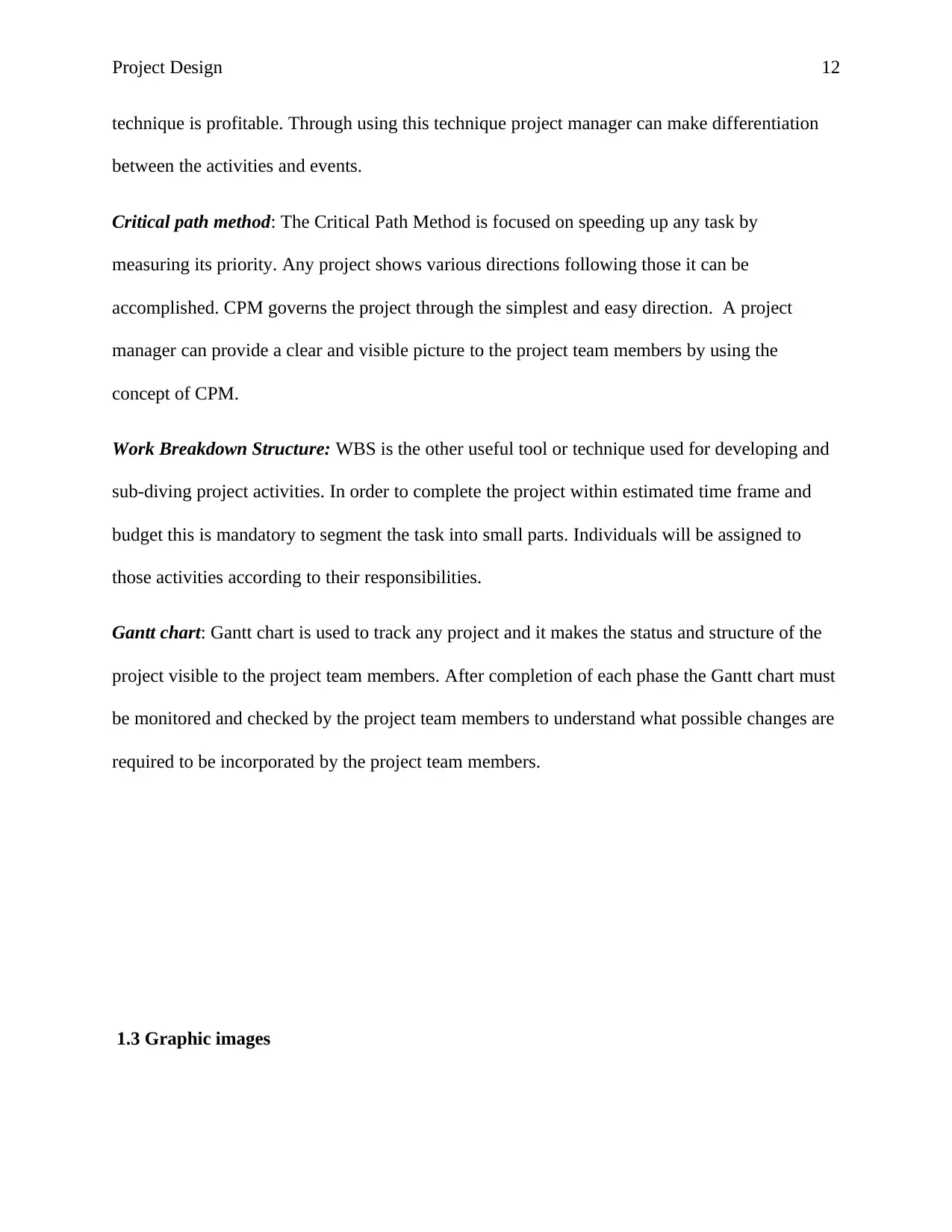
Project Design 12
technique is profitable. Through using this technique project manager can make differentiation
between the activities and events.
Critical path method: The Critical Path Method is focused on speeding up any task by
measuring its priority. Any project shows various directions following those it can be
accomplished. CPM governs the project through the simplest and easy direction. A project
manager can provide a clear and visible picture to the project team members by using the
concept of CPM.
Work Breakdown Structure: WBS is the other useful tool or technique used for developing and
sub-diving project activities. In order to complete the project within estimated time frame and
budget this is mandatory to segment the task into small parts. Individuals will be assigned to
those activities according to their responsibilities.
Gantt chart: Gantt chart is used to track any project and it makes the status and structure of the
project visible to the project team members. After completion of each phase the Gantt chart must
be monitored and checked by the project team members to understand what possible changes are
required to be incorporated by the project team members.
1.3 Graphic images
technique is profitable. Through using this technique project manager can make differentiation
between the activities and events.
Critical path method: The Critical Path Method is focused on speeding up any task by
measuring its priority. Any project shows various directions following those it can be
accomplished. CPM governs the project through the simplest and easy direction. A project
manager can provide a clear and visible picture to the project team members by using the
concept of CPM.
Work Breakdown Structure: WBS is the other useful tool or technique used for developing and
sub-diving project activities. In order to complete the project within estimated time frame and
budget this is mandatory to segment the task into small parts. Individuals will be assigned to
those activities according to their responsibilities.
Gantt chart: Gantt chart is used to track any project and it makes the status and structure of the
project visible to the project team members. After completion of each phase the Gantt chart must
be monitored and checked by the project team members to understand what possible changes are
required to be incorporated by the project team members.
1.3 Graphic images
⊘ This is a preview!⊘
Do you want full access?
Subscribe today to unlock all pages.

Trusted by 1+ million students worldwide
1 out of 32
Related Documents
Your All-in-One AI-Powered Toolkit for Academic Success.
+13062052269
info@desklib.com
Available 24*7 on WhatsApp / Email
![[object Object]](/_next/static/media/star-bottom.7253800d.svg)
Unlock your academic potential
Copyright © 2020–2025 A2Z Services. All Rights Reserved. Developed and managed by ZUCOL.




